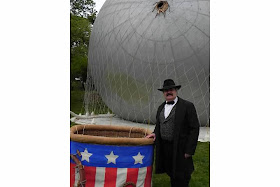This past weekend my parents were visiting and helping me with the boys while my wife was out of town. I was looking for a family-friendly activity to fill Saturday morning. (Believe me, with 22 month-old twins, it's best to get out and about.) Lucky for us, the
Ft. Ward Museum and Historic Site in Alexandria was holding a "Civil War Balloon Corps Living History Event." So we packed into the SUV and headed to one of my favorite Civil War sites in the Washington area.
The event featured a reenactor portraying Thaddeus S.C. Lowe, the head of the Union Army's Balloon Corps. Kevin Knapp, a retired Army officer and professional balloonist, has established a name for himself as an expert on Lowe and the military use of balloons during the Civil War. He set up a balloon on the grounds of Ft. Ward, complete with replica gas generators and a basket draped in patriotic bunting. The balloon is actually a 1941 Navy trainer, but bears a resemblance to the type of netted gas balloons used by Lowe and other period aeronauts. Incidentally, Knapp is the same reenactor who made a widely-publicized appearance on the the National Mall last summer as part of a reenactmet of Lowe's June 1861 balloon demonstration for President Abraham Lincoln.
 |
| Thaddeus S.C. Lowe (Kevin Knapp) poses in front of his balloon. Knapp, a professional balloon pilot, brings first-hand flying experience to his interpretation of Civil War aviation. |
 |
| View of the balloon attached to replica gas generators on the grounds of Ft. Ward. Knapp explained to me that the actual balloon was used by the Navy to transition pilots from light-than-air flight to airships. The Genesee County Village & Museum in Mumford, New York is currently building an exact replica of one of Lowe's balloons and will offer rides to visitors. |
 |
| Lowe inflating his balloon Intrepid at Fair Oaks, Virginia. Note the gas generators mounted on wagons. The event at Ft. Ward replicated a wartime scene like the one above (courtesy of Smithsonian Air & Space Museum). |
Knapp could not fully inflate the balloon due in part to the airspace restrictions around the nation's capital. That's too bad, because many spectators surely had come to see the balloon floating high above the fort and museum. On the other hand, Knapp was on the ground and available to answer questions. I spoke with the reenactor for a few minutes and learned quite a bit about the Balloon Corps in such a short amount of time. I am not too familiar with the subject, and Knapp whetted my appetite to learn more. His enthusiasm for the topic was contagious.
 |
| View of a replica gas generator used to inflate balloons in the field. Balloonists mixed sulfuric acid and iron filings to produce hydrogen gas. The gas flowed from the generator to the balloon. Of course, authenticity only goes so far, and Knapp uses a cold air fan to inflate his balloon. The two replica generators at the event were somewhat smaller than the originals because Knapp built them to fit on wagons provided to him for last year's reenactment on the Mall. |
 |
| The event featured a miniature replica of a Civil War balloon, which floated above the trees at Ft. Ward. At least spectators were able to see something in the air without Knapp and museum staff drawing the ire of the Federal authorities. |
The West End of Alexandria, where Ft. Ward is located, was no stranger to military ballooning during the Civil War. In the fall of 1861, John LaMountain, one of Lowe's rivals, obtained a job with Gen. William B. Franklin's division at Cloud's Mill, not far from Ft. Ward. Earlier in 1861, La Mountain had served with Gen. Benjamin Butler at Ft. Monroe, but a new Federal commander there had little appreciation for aerial technology and sent LaMountain to Washington.
Unlike Lowe, who tethered his balloons to the ground, La Mountain believed in free flight reconnaissance. LaMountain may have possessed an on-site gas generator, but he also filled his balloons at a lighting gas plant in Alexandria. LaMountain ascended at least seven times while based in Alexandria. As he floated over Northern Virginia, LaMountain was able to observe the Confederate lines around Centreville, Manassas, and other spots. LaMountain never fully accepted Lowe's appointment as head of the Balloon Corps and incessantly criticized his rival. Gen. George B. McClellan eventually dismissed LaMountain for insubordination in February 1862. (I'd like to take a closer look at La Mountain's activities in future posts.)
The fact that there is a reenactor portraying Lowe, and not LaMountain, says a lot about how we've come to remember the wartime balloonists. I discussed with Knapp why Lowe still captures the public's imagination, while other aeronauts, like LaMountain, have drifted into obscurity. (No pun intended.) The fact that Lowe had correspondents following his every move, and that he had friends in high places may have had something to do with ensuring Lowe's place in history. Wartime photographers also seemed obsessed with Lowe's military operations and left a remarkable visual record for future generations. In any event, it's refreshing to see living history events aside from battle reenactments, and Knapp's impression of Lowe helps to focus public attention on an interesting aspect of the Civil War and technology.
Sources
Timothy J. Dennee,
"John LaMountain and the Alexandria Balloon Ascensions," Historic Alexandria Quarterly, Vol. 2, No. 3, Fall 1997; U.S. Centennial of Flight Commission,
"Balloons in the American Civil War;" Brett Zongker, Associated Press,
"Smithsonian Recounts Balloon Flights of Civil War," June 10, 2011.






No comments:
Post a Comment